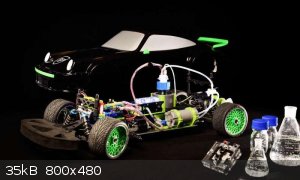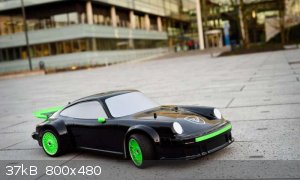Formic Acid Fuel Cell
https://en.wikipedia.org/wiki/Formic_acid_fuel_cell
http://phys.org/news/2010-12-formic-acid.html
http://phys.org/news/2016-01-dutch-student-team-world-car.html
http://onlinelibrary.wiley.com/wol1/doi/10.1002/cctc.201402119/full
Anode: HCOOH → CO2 + 2 H+ + 2 e−
Cathode: 1/2 O2 + 2 H+ + 2 e− → H2O
Net reaction: HCOOH + 1/2 O2 → CO2 + H2O
| Quote: | It is probably in the automotive field that the invention has the greatest potential. Currently, the prototypes produced by certain carmakers store
hydrogen in conventional form, which entails problems such as risk of explosion, large volume pressurized tanks, difficulties in filling the tank
quickly, etc.
The vehicles of the 21st century may run on formic acid. This solution allows for safer, more compact hydrogen storage as well as easier filling at
the pump – formic acid is liquid at room temperature. “Technically, it is quite feasible. In fact, a number of major automobile manufacturers
contacted us in 2008, when oil prices reached record highs,” says Gabor Laurenczy. “In my opinion, the only obstacle is cost.” It will be
several years before drivers can pull up to any anthill and fill their tanks. |
| Quote: | | Formic acid(FA) produced by the catalytic hydrogenation of CO2 is recognized as a potential intermediate H2 carrier. Herein, we present the
development of a formate-based H2 storage system that employs a Ru PNP-pincer catalyst. The high stability of this system allows cyclic
operation with an exceptionally fast loading and liberation of H2. Kinetic studies highlight the crucial role of the base promoter, which
controls the rate determining step in FA dehydrogenation and defines the total H2 capacity attainable from the hydrogenation of CO2. The
reported findings show promise for the development of practical technologies that use formic acid as a hydrogen carrier. |
| Quote: | Building a car that is powered by formic acid. That is the ambition of Team FAST, a new student team from Eindhoven University of Technology (TU/e).
Since formic acid can store hydrogen, an environmentally-friendly fuel, it has more benefits than existing hydrogen or electric powered cars. Today
the team presents the first concrete step: a scale model, a meter in size, which is able to drive on formic acid alone.
By using formic acid as a fuel, the TU/e student team Team FAST hopes to combine the strengths of electric and hydrogen powered cars without any of
the drawbacks. Electric cars depend on batteries and thus have a limited range. An electric car can go further using hydrogen but the drawback here is
that hydrogen is expensive to transport and store, and it also has to be transported under high pressure.
High speed
Formic acid - so called because ants (formica in Latin) and other insects can produce it - offers the possibility to store hydrogen easily. A chemical
reaction, discovered last year by TU/e researchers, enables hydrogen and CO2 to be converted at high speed into formic acid, and vice versa. Due to
the liquid nature of formic acid, hydrogen can be transported easily and cheaply.
Equivalent to gasoline
Team FAST sees possibilities for these reactions to take place in a car, whereby hydrogen is used to power an electric engine. For the consumer using
formic acid will be like using gasoline. This similarity will also ensure that formic acid can easily be incorporated into the existing fuel
infrastructure, Next to that, formic acid can be much more widely applied as an energy carrier; solar and wind energy can also be stored in formic
acid, and then used when required. |
 
[Edited on 1-15-2016 by Detonationology]
[Edited on 1-15-2016 by Detonationology]
“There are no differences but differences of degree between different degrees of difference and no difference.” ― William James
|